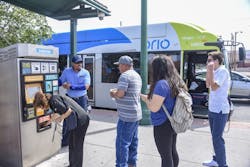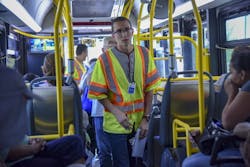Determining the impacts of bus rapid transit in the city of El Paso
The city of El Paso, Texas—which ranks as the 22nd largest city in the U.S. with its approximately 682,000 residents—is a uniquely positioned major metropolitan area in the nation as it not only exists along a state border, but a national one as well.
The Sun City lies in close proximity to Las Cruces, New Mexico, while also sharing a border with the city of Ciudad Juarez in Mexico. The downtown regions of Ciudad Juarez and El Paso are directly linked, providing for numerous opportunities for intercity travel and commuting, particularly for work opportunities on both sides of the border.
City officials for some time now have been trying to offer solutions to the city’s traffic congestion as well as the health concerns for residents, as 16% of adult residents in El Paso are diabetic and 34% struggle with obesity. With these factors in mind, implementing solutions that would incentivize residents to walk and ride bicycles are among the city’s goals.
As part of an effort to evaluate health, environmental, and time-saving travel benefits for El Paso residents and transit users, the Texas A&M Transportation Institute’s (TTI) Center for International Intelligent Transportation Research teamed up with Texas A&M University’s Department of Landscape Architecture and Urban Planning to determine if residents of El Paso—who live in an urban area that has typically been known for being more car-oriented when it comes to transportation—were willing to walk further as part of their daily travel after the implementation of a new bus rapid transit (BRT) line.
Background
The city of El Paso initiated a collaborative relationship with TTI with the goal of bringing bus rapid transit to the city back in 2008. At the time, the city government was pushing to make El Paso among the top cities in the country for public transportation. The city was also seeing a plethora of its ridership commuting from Ciudad Juarez every day, and the Sun Metro—El Paso’s metro transit system—was serving nearly 14 million riders annually.
The road to adopting a bus rapid transit system began when TTI started work on an alternative analysis for the BRT system, which is required by the Federal Transit Administration (FTA) to ensure the system would be the best option for the city. Conducting origin-destination surveys with transit users and mapping out the corridor configuration for what eventually would become the four BRT corridors in El Paso were all part of the work conducted by TTI to help the city plan for bus rapid transit.
“At the time, we worked with the existing routes, existing conditions, and how to reconfigure the existing routes to serve as the feeder of this new corridor,” David Galicia, assistant research scientist at TTI, told Traffic & Transit. “And we proposed to eliminate some existing routes in 2008 and accommodate everything so the main corridors could serve the BRT system while other routes could still work to pick up residents in other areas. [We wanted to] concentrate the ridership in terminal stations so the BRT could serve its purpose.”
The routes
The various efforts to bring bus rapid transit to El Paso came to fruition in the form of the Mesa BRT Corridor, which was the first of its kind to open in El Paso in 2014. TTI recommended the city begin with the Mesa Corridor, which begins at the Downtown Transit Center and stretches for 22 stations across the metro area moving northwest to the Westside Transit Center. “It was the first one that met the required ridership that the Federal Transit Administration asked for,” Galicia said. The Mesa BRT Corridor has a total of 10 buses serving its 8.6-mile route.
Today, Sun Metro’s BRT system is known as Sun Metro Brio. In 2019, Brio saw two more BRT corridors open up to the public. The new Alameda Corridor stretches 14.5 miles across 29 stations from the Downtown Transit Center going south to the Mission Valley Transit Center with a total of 14 buses, while the Dyer Corridor travels north from downtown for 11.4 miles across 22 stations to the Northgate Transit Center with a total of 10 buses.
El Paso will see the Montana Corridor—its fourth and final BRT line—finish up in 2020. The Montana Corridor will be the longest BRT line in the Brio system, stretching 16.8 miles across 25 stations. It will begin at the Five Points Transfer Center, which lies just slightly northeast of the Downtown Transit Center, and will extend further east to the future Far East Transfer Center. The total project cost for the Montana Corridor is $47 million and will include 14 buses on the BRT line. The FTA is expected to fund $29.5 million of the cost, while the Texas DOT has committed $8 million to the project.
Data collection
While the delivery of the four BRT lines to the residents of El Paso is nearly complete, TTI still has plenty of work to do. Their work is currently in the data collection process, which is the first of three phases. The goal is to compare before-and-after scenarios of implementing the Alameda Corridor BRT line. The TTI research team is busy employing a strategy to acquire data on daily ridership that involves public participation. After this, the team will produce a computer-based model using a software called Transcape to assess current conditions and build-out scenarios.
“The project started two years ago, and last year we were collecting origin-destination data on all the existing routes along the Alameda corridor,” Galicia explained. “Now that the BRT started running, we need that second phase of data collection, because now we are going to have some ridership—a real number of riders that are taking the bus—and we want to compare the before and after; and also we want to calibrate our models using this information. So over the last year, we were getting a number of riders, and also origin-destination surveys. Now we’re going to get a second round of origin-destination passenger counts this year.”
Galicia explained that the team at TTI is in the process of building its base model to assess the “before” conditions for Sun Metro’s routes and will compare those results with the data collected after El Paso area riders have experienced the BRT line. “Once we get everything input in our model, we can build our scenario, which is one of our final products,” Galicia said. “We’re going to forecast our ridership and our transit model five years from now, so we will be able to say what the expected conditions will be for 2024, and also we want to expand [the forecast] to a total of 10 years.”
At present, TTI also is continuing to work with El Paso County to optimize their transit routes, as the rural transit service currently requires transferring to the Sun Metro line. “That’s something that’s not really efficient for the rider,” Galicia said. “Because they need to pay a fare for El Paso County and transfer to the Sun Metro system, and they need to pay again for a different service, meaning they don’t have an option to get a transfer ticket between systems of El Paso County and city. So we are helping El Paso County with reconfiguring the routes.”
Benefits
The ultimate goal for the city of El Paso is to have four BRT corridors that connect the entire city in the hopes that more residents will leave their cars behind and adopt healthier habits such as walking and biking that would be accommodated with the BRT system. For residents of the city of El Paso, taking the Sun Metro Brio buses also offers various modern conveniences, including air conditioning, Wi-Fi connection, bicycle racks for cyclists, and comfortable seating.
TTI is continuing to work out calculating the total benefits that will come about as the result of the new system, but the anticipated benefits include travel-time savings, fewer bus-related crashes as a result of fewer buses in the system, and reduced congestion along roadways.



